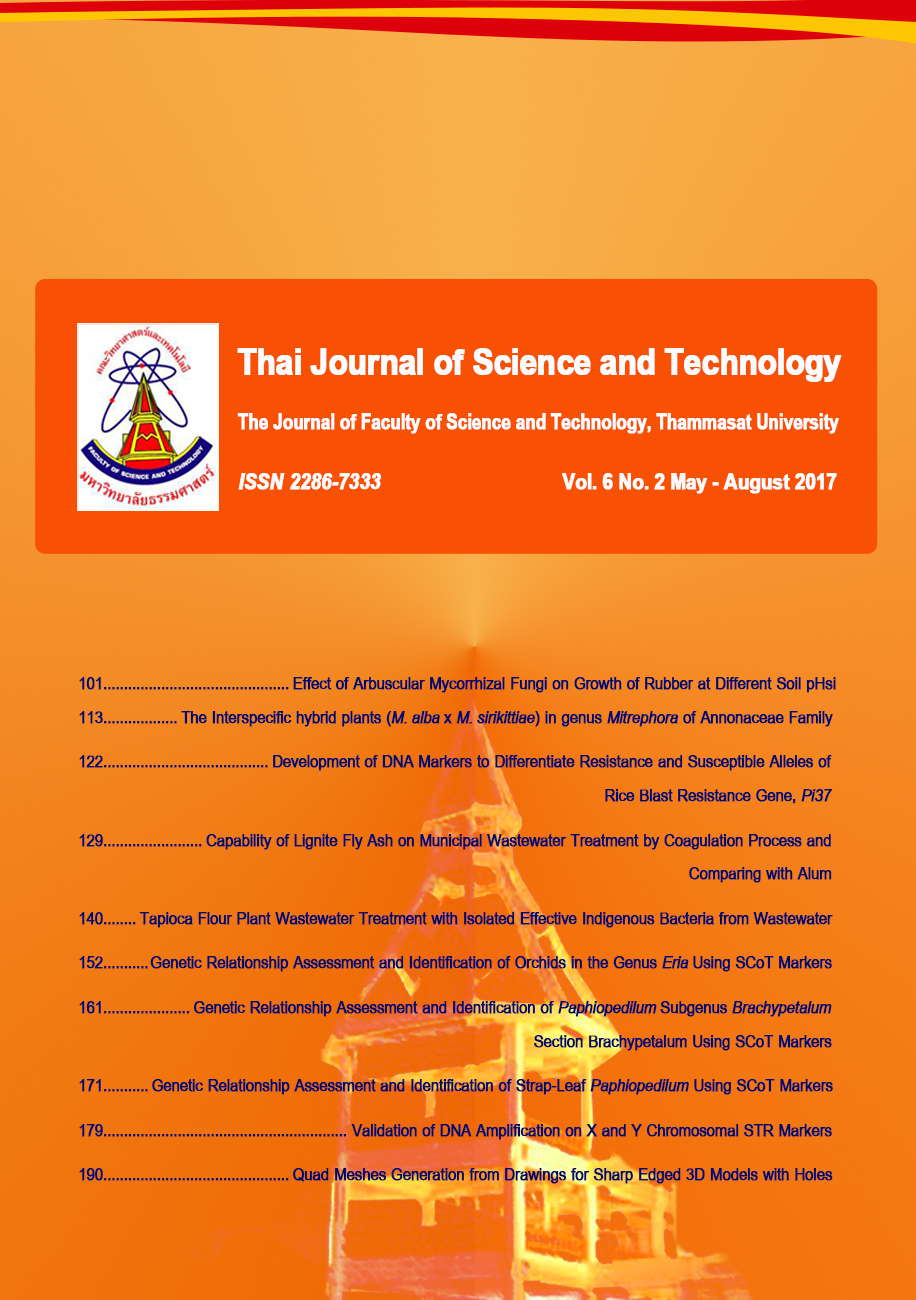การบำบัดน้ำเสียจากโรงงานผลิตแป้งมันสำปะหลังด้วยแบคทีเรียท้องถิ่นที่มีประสิทธิภาพที่คัดเลือกได้จากน้ำเสีย
Main Article Content
Abstract
บทคัดย่อ
งานวิจัยนี้มีวัตถุประสงค์เพื่อพัฒนาประสิทธิภาพการบำบัดน้ำเสียจากโรงงานผลิตแป้งมันสำปะหลังขนาดกลางและขนาดย่อม ค่าซีโอดีจากการวิเคราะห์น้ำเสียตัวอย่างเท่ากับ 19,200 มก./มล. ทดลองโดยคัดเลือกแบคทีเรียประจำถิ่นที่มีความสามารถในการย่อยสลายแป้งได้ดีจากน้ำเสียตัวอย่าง พบว่า Bacillus OSH2 มีความสามารถในการย่อยสลายแป้งในน้ำเสียสังเคราะห์ได้ดี จากนั้นศึกษาสภาวะที่เหมาะสมกับการเจริญเติบโตในน้ำเสียสังเคราะห์ 100 มล. พบว่าเจริญเติบโตได้ดีที่ pH 8 เติมโมโนโซเดียมกลูตาเมท 0.3 ก. และโพแทสเซียมไดไฮโดรเจนฟอสเฟต 0.1 ก. เมื่อปรับสภาพน้ำเสียสังเคราะห์ตามผลการศึกษาพบว่า Bacillus OSH2 สามารถย่อยสลายแป้งมันสำปะหลังได้หมดภายใน 6 ชั่วโมง และเมื่อศึกษาในน้ำเสียจริงลดค่าซีโอดีได้ร้อยละ 86.67 เมื่อทดลองในถังปฏิกรณ์ระดับห้องปฏิบัติการด้วยน้ำเสียจริง หน่วยการทดลองบำบัดน้ำเสียแบบเติมอากาศที่ปรับสภาพน้ำเสียมีประสิทธิภาพในการกำจัดซีโอดีได้สูงที่สุด คือ ร้อยละ 75.06 แต่ถ้าน้ำที่ผ่านการบำบัดยังมีค่าซีโอดีเกินค่ามาตรฐานน้ำทิ้งโรงงานอุตสาหกรรมของกรมควบคุมมลพิษ แก้ไขปัญหาโดยการเจือจางน้ำเสียก่อนบำบัด หรือบำบัดซ้ำอีกครั้ง ซึ่งลดค่าซีโอดีได้ร้อยละ 90.90 และร้อยละ 83.50 ตามลำดับ
คำสำคัญ : น้ำเสียจากโรงงานผลิตแป้งมันสำปะหลัง; แบคทีเรียท้องถิ่น; ซีโอดี
Abstract
The purpose of this research was to develop the effective wastewater treatment for SME tapioca flour plant. The COD from analysis of wastewater sample was 19,200 mg/L. The experiment was isolation of indigenous microorganism with good ability to degrade residual starch from wastewater samples. It was found that Bacillus OSH2 had higher effective ability to degrade starch. After that, the optimum condition for 100 mL of synthetic wastewater was established at pH 8, with adding 0.3 g monosodium glutamate and 0.1 g KH2PO4. The Bacillus OSH2 could degrade tapioca flour completely in 6 hours in adjusted synthetic wastewater and reduce COD at 86.67 % in raw wastewater at optimum condition. The lab scale reactor experiments was investigated. The treatment unit which adjusted pH raw wastewater with adding N, P nutrients and aerobic condition, was the best COD removal efficiency at 75.06 %. If the treated water had COD value above the industrial standard criteria of PCD, this problem could be solved by retreatment with the same condition or dilution the raw wastewater before treatment. It was noticed that dilution method had more efficiency to reduce COD at 90.09 % while retreatment method reduced COD at 86.67 %.
Keywords: tapioca flour plant wastewater; indigenous bacteria; COD
Article Details
บทความที่ได้รับการตีพิมพ์เป็นลิขสิทธิ์ของคณะวิทยาศาสตร์และเทคโนโลยี มหาวิทยาลัยธรรมศาสตร์ ข้อความที่ปรากฏในแต่ละเรื่องของวารสารเล่มนี้เป็นเพียงความเห็นส่วนตัวของผู้เขียน ไม่มีความเกี่ยวข้องกับคณะวิทยาศาสตร์และเทคโนโลยี หรือคณาจารย์ท่านอื่นในมหาวิทยาลัยธรรมศาสตร์ ผู้เขียนต้องยืนยันว่าความรับผิดชอบต่อทุกข้อความที่นำเสนอไว้ในบทความของตน หากมีข้อผิดพลาดหรือความไม่ถูกต้องใด ๆ


